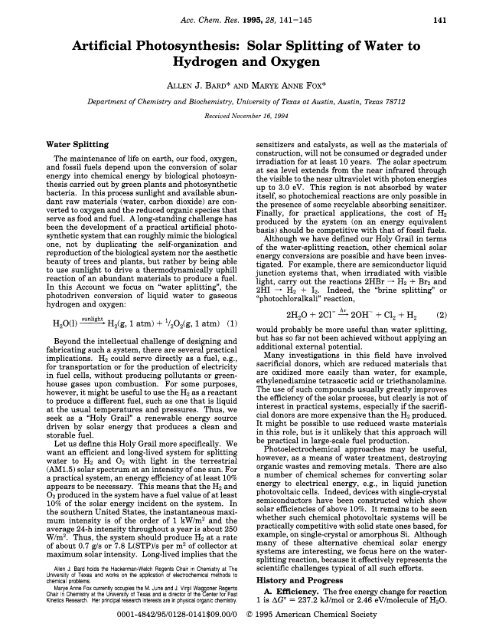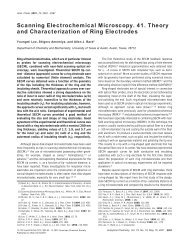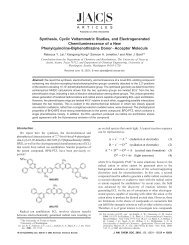Artificial Photosynthesis: Solar Splitting of Water to ... - Allen J. Bard
Artificial Photosynthesis: Solar Splitting of Water to ... - Allen J. Bard
Artificial Photosynthesis: Solar Splitting of Water to ... - Allen J. Bard
Create successful ePaper yourself
Turn your PDF publications into a flip-book with our unique Google optimized e-Paper software.
Acc. Chem. Res. 1995,28, 141-145 141<strong>Artificial</strong> <strong>Pho<strong>to</strong>synthesis</strong>: <strong>Solar</strong> <strong>Splitting</strong> <strong>of</strong> <strong>Water</strong> <strong>to</strong>Hydrogen and OxygenALLEN J. BARD* AND MARYE ANNE Fox*Department <strong>of</strong> Chemistry and Biochemistry, University <strong>of</strong> Texas at Austin, Austin, Texas 78712Received November 16, 1994<strong>Water</strong> <strong>Splitting</strong>The maintenance <strong>of</strong> life on earth, our food, oxygen,and fossil fuels depend upon the conversion <strong>of</strong> solarenergy in<strong>to</strong> chemical energy by biological pho<strong>to</strong>synthesiscarried out by green plants and pho<strong>to</strong>syntheticbacteria. In this process sunlight and available abundantraw materials (water, carbon dioxide) are converted<strong>to</strong> oxygen and the reduced organic species thatserve as food and fuel. A long-standing challenge hasbeen the development <strong>of</strong> a practical artificial pho<strong>to</strong>syntheticsystem that can roughly mimic the biologicalone, not by duplicating the self-organization andreproduction <strong>of</strong> the biological system nor the aestheticbeauty <strong>of</strong> trees and plants, but rather by being able<strong>to</strong> use sunlight <strong>to</strong> drive a thermodynamically uphillreaction <strong>of</strong> an abundant materials <strong>to</strong> produce a fuel.In this Account we focus on “water splitting”, thepho<strong>to</strong>driven conversion <strong>of</strong> liquid water <strong>to</strong> gaseoushydrogen and oxygen:Beyond the intellectual challenge <strong>of</strong> designing andfabricating such a system, there are several practicalimplications. H2 could serve directly as a fuel, e.g.,for transportation or for the production <strong>of</strong> electricityin fuel cells, without producing pollutants or greenhousegases upon combustion. For some purposes,however, it might be useful <strong>to</strong> use the HZ as a reactant<strong>to</strong> produce a different fuel, such as one that is liquidat the usual temperatures and pressures. Thus, weseek as a “Holy Grail” a renewable energy sourcedriven by solar energy that produces a clean ands<strong>to</strong>rable fuel.Let us define this Holy Grail more specifically. Wewant an efficient and long-lived system for splittingwater <strong>to</strong> Ha and 0 2 with light in the terrestrial(AM1.5) solar spectrum at an intensity <strong>of</strong> one sun. Fora practical system, an energy efficiency <strong>of</strong> at least 10%appears <strong>to</strong> be necessary. This means that the HZ and0 2 produced in the system have a fuel value <strong>of</strong> at least10% <strong>of</strong> the solar energy incident on the system. Inthe southern United States, the instantaneous maximumintensity is <strong>of</strong> the order <strong>of</strong> 1 kW/m2 and theaverage 24-h intensity throughout a year is about 250W/m2. Thus, the system should produce H2 at a rate<strong>of</strong> about 0.7 g/s or 7.8 L(STP)/s per m2 <strong>of</strong> collec<strong>to</strong>r atmaximum solar intensity. Long-lived implies that the<strong>Allen</strong> J. <strong>Bard</strong> holds the Hackerman-Welch Regents Chair in Chemistry at TheUniversity <strong>of</strong> Texas and works on the application <strong>of</strong> electrochemical methods <strong>to</strong>chemical problems.Marye Anne Fox currently occupies the M. June and J. Virgil Waggoner RegentsChair in Chemistry at the University <strong>of</strong> Texas and is direc<strong>to</strong>r <strong>of</strong> the Center for FastKinetics Research. Her principal research interests are in physical organic chemistry0001-4842/95/0128-0141$09.00/0sensitizers and catalysts, as well as the materials <strong>of</strong>construction, will not be consumed or degraded underirradiation for at least 10 years. The solar spectrumat sea level extends from the near infrared throughthe visible <strong>to</strong> the near ultraviolet with pho<strong>to</strong>n energiesup <strong>to</strong> 3.0 eV. This region is not absorbed by wateritself, so pho<strong>to</strong>chemical reactions are only possible inthe presence <strong>of</strong> some recyclable absorbing sensitizer.Finally, for practical applications, the cost <strong>of</strong> H2produced by the system (on an energy equivalentbasis) should be competitive with that <strong>of</strong> fossil fuels.Although we have defined our Holy Grail in terms<strong>of</strong> the water-splitting reaction, other chemical solarenergy conversions are possible and have been investigated.For example, there are semiconduc<strong>to</strong>r liquidjunction systems that, when irradiated with visiblelight, carry out the reactions 2HBr - H2 + Br2 and2HI - HZ + 12. Indeed, the “brine splitting” or“pho<strong>to</strong>chloralkali“ reaction,2H,O + 2C1- hv 20H- + C1, + H, (2)would probably be more useful than water splitting,but has so far not been achieved without applying anadditional external potential.Many investigations in this field have involvedsacrificial donors, which are reduced materials thatare oxidized more easily than water, for example,ethylenediamine tetraacetic acid or triethanolamine.The use <strong>of</strong> such compounds usually greatly improvesthe efficiency <strong>of</strong> the solar process, but clearly is not <strong>of</strong>interest in practical systems, especially if the sacrificialdonors are more expensive than the H2 produced.It might be possible <strong>to</strong> use reduced waste materialsin this role, but is it unlikely that this approach willbe practical in large-scale fuel production.Pho<strong>to</strong>electrochemical approaches may be useful,however, as a means <strong>of</strong> water treatment, destroyingorganic wastes and removing metals. There are alsoa number <strong>of</strong> chemical schemes for converting solarenergy <strong>to</strong> electrical energy, e.g., in liquid junctionpho<strong>to</strong>voltaic cells. Indeed, devices with single-crystalsemiconduc<strong>to</strong>rs have been constructed which showsolar efficiencies <strong>of</strong> above 10%. It remains <strong>to</strong> be seenwhether such chemical pho<strong>to</strong>voltaic systems will bepractically competitive with solid state ones based, forexample, on single-crystal or amorphous Si. Althoughmany <strong>of</strong> these alternative chemical solar energysystems are interesting, we focus here on the watersplittingreaction, because it effectively represents thescientific challenges typical <strong>of</strong> all such efforts.His<strong>to</strong>ry and ProgressA. Efficiency. The free energy change for reaction1 is AGO = 237.2 kJ/mol or 2.46 eV/molecule <strong>of</strong> H2O.0 1995 American Chemical Society
142 Acc. Chem. Res., Vol. 28, No. 3, 1995Since two electrons are involved in the reaction aswritten (n = 2), this corresponds <strong>to</strong> 1.23 eV/e, whichis also the standard emf for the reaction. The pho<strong>to</strong>nsin the solar spectrum provide sufficient energy <strong>to</strong> drivethis reaction, but the efficiency <strong>of</strong> the reaction dependsupon how the reaction is carried out. It is possible <strong>to</strong>cause water splitting thermally with light via concentra<strong>to</strong>rsand a solar furnace by heating water <strong>to</strong> 1500-2500 K.I However, the efficiency <strong>of</strong> this process istypically below 2%, and the cost <strong>of</strong> the capital equipmentand material stability problems suggest that thisapproach <strong>to</strong> solar water splitting is not a promisingone.Since water itself does not absorb appreciable radiationwithin the solar spectrum, one or more lightabsorbingspecies (pho<strong>to</strong>converters or sensitizers)must be used <strong>to</strong> transduce the radiant energy <strong>to</strong>chemical (or electrical) energy in the form <strong>of</strong> electronlhole pairs, i.e., <strong>to</strong> the oxidizing and reducing potentialneeded <strong>to</strong> drive the reaction. The maximum efficiencyfor pho<strong>to</strong>chemical solar converters has been consideredin a number <strong>of</strong> papers2 and depends upon the bandgap (or threshold energy), E,, <strong>of</strong> the pho<strong>to</strong>converter.Radiation <strong>of</strong> energy below E, is not absorbed whilethat above E, is partly lost as heat by internalconversion or intraband thermalization processes.Additional thermodynamic losses occur because theexcited state concentration is only a fraction <strong>of</strong> that<strong>of</strong> the ground state and because some excited statesare lost through radiative decay.2 When these fac<strong>to</strong>rsare taken in<strong>to</strong> account, the threshold pho<strong>to</strong>n energyand the maximum efficiency can be calculated. For asingle pho<strong>to</strong>converter system, wavelengths below 770nm (or energies above 1.6 eV) are required <strong>to</strong> yield amaximum efficiency <strong>of</strong> about 30%. Lower pho<strong>to</strong>nenergies and higher efficiencies are attainable if oneemploys two pho<strong>to</strong>converters. Thus for a system withtwo pho<strong>to</strong>converters with two different, optimized E,values, one finds a maximum solar efficiency <strong>of</strong> 41%.2These calculations show that, in principle, the desiredefficiency for water splitting is attainable, even witha system involving a single pho<strong>to</strong>converter.B. Semiconduc<strong>to</strong>r Solid State Pho<strong>to</strong>voltaic-Based Systems. A number <strong>of</strong> different approachesare possible with semiconduc<strong>to</strong>rs as the pho<strong>to</strong>converter.The most direct, brute force, approach employsa solid state pho<strong>to</strong>voltaic solar cell <strong>to</strong> generate electricitythat is then passed in<strong>to</strong> a commercial-typewater electrolyzer (Figure 1A). The maximum theoreticalefficiency for a Si pho<strong>to</strong>voltaic cell is 33%, andthe efficiencies <strong>of</strong> the best labora<strong>to</strong>ry cells have beenreported <strong>to</strong> be about 24%. Commercial single-crystalSi solar cells generally have efficiencies in the 12-16% range. The electrolysis <strong>of</strong> water at a reasonablerate in a practical cell requires applied voltagessignificantly larger than the theoretical value (1.23 Vat 25 "C), and electrolysis energy efficiencies <strong>of</strong> about60% are typical. Thus, the efficiency <strong>of</strong> the combinedsolar/electrolyzer system using commercially availablecomponents is close <strong>to</strong> the desired 10% defined forsolar hydrogen generation. Moreover, the componentsare rugged and should be long-lived. The problemwith such a system is its cost. <strong>Solar</strong> pho<strong>to</strong>voltaicscannot currently produce electricity at competitive(1) Etievant, C. <strong>Solar</strong> Energy Muter. 1991, 24, 413.(Z)Archer, M. D.; Bol<strong>to</strong>n, J. R. J. Phys. Chem. 1990, 94, 8028 andreferences therein.te'b%-JPho<strong>to</strong>voltaic hv, cell ,/ElectrolysisAn-tw semiconduc<strong>to</strong>rnlpB<strong>Bard</strong> and FoxII 4 2/ \semiconduc<strong>to</strong>r dye layerCDFigure 1. Schematic diagrams <strong>of</strong> different types <strong>of</strong> semiconduc<strong>to</strong>r-basedsystems proposed for solar water splitting: (A)solid state pho<strong>to</strong>voltaic cell driving a water electrolyzer; (B) cellwith immersed semiconduc<strong>to</strong>r p/n junction (or metallsemiconduc<strong>to</strong>rSchottky junction) as one electrode; (C) liquid junctionsemiconduc<strong>to</strong>r electrode cell; (D) cell with dye-sensitized semiconduc<strong>to</strong>relectrode.prices, and hydrogen from water electrolyzers issignificantly more expensive than that produced chemicallyfrom coal or natural gas. Lower cost solar cellsare possible, e.g., through the use <strong>of</strong> polycrystallineor amorphous Si or other semiconduc<strong>to</strong>rs (CdS, CdTe,CuInSed, and some improvements in water electrolyzerefficiency through better configurations andcatalysts and the use <strong>of</strong> higher temperatures arepossible. However, it probably will be difficult <strong>to</strong> bringthe overall cost down <strong>to</strong> levels that make such aconfiguration practical in the foreseeable future.An alternative system involves the semiconduc<strong>to</strong>rpho<strong>to</strong>voltaic cell immersed directly in the aqueoussystem (Figure 1B). At the least this eliminates thecosts and mechanical difficulties associated with separateconstruction and interconnection <strong>of</strong> solar andelectrochemical cells. In one such system, the electrodesare composed <strong>of</strong> single or multiple semiconduc<strong>to</strong>rp/n junctions that are irradiated while they arewithin the cell. This simpler apparatus is attainedat the cost <strong>of</strong> encapsulating and coating the semiconduc<strong>to</strong>rs<strong>to</strong> protect them from the liquid environmentand probably with a more limited choice <strong>of</strong> electrocatalystfor 0 2 or H2 evolution. Moreover, the opencircuitpho<strong>to</strong>voltage <strong>of</strong> a single Si p/n junction is only0.55 V, so at least three <strong>of</strong> these in series would beneeded <strong>to</strong> generate the necessary potential for watersplitting. For example, in a system developed at TexasInstruments3 (TI) p-Si/n-Si junctions were producedon small (0.2 mm diameter) Si spheres embedded inglass and backed by a conductive layer <strong>to</strong> form an(3) Kilby, J. S.; Lathrop, J. W.; Porter, W. A. US. Patent 4 021 323,1977; U.S. Patent 4 100 051, 1978; U.S. Patent 4 136 436, 1979. Seealso: Johnson, E. L. In Electrochemistry in Industry; Landau, U., Yeager,E., Kortan, D., Eds.; Plenum: New York, 1982; pp 299-306.
<strong>Artificial</strong> <strong>Pho<strong>to</strong>synthesis</strong>array. Each sphere behaved as a pho<strong>to</strong>voltaic cell andproduced about 0.55 V. The use <strong>of</strong> two arrays,protected with noble metal catalysts (M), i.e., Wp-Si/n-Si and M/n-Sup-Si, connected in series and incontact with HBr, allowed H2 and Bra <strong>to</strong> be generatedwith about an 8% efficiency. Multiple TI pho<strong>to</strong>arraycells <strong>to</strong> carry out water splitting and other reactionsrequiring higher potentials are possible4 at a considerablesacrifice in efficiency. Note that, in addition <strong>to</strong>p/n semiconduc<strong>to</strong>r junctions, those between a metaland semiconduc<strong>to</strong>r (Schottky barriers) can be used <strong>to</strong>produce a pho<strong>to</strong>potential, e.g., in electrodes such asAdn-Gap, PtSUn-Si, and Pun-GaAs.C. Semiconduc<strong>to</strong>r Electrode (Liquid Junction)Systems. Of more interest <strong>to</strong> chemists aresystems in which the pho<strong>to</strong>potential <strong>to</strong> drive thewater-splitting reaction is generated directly at thesemiconduc<strong>to</strong>rAiquid interface (Figure IC). In 1839Becquerel noted small pho<strong>to</strong>effects when metal electrodeswere irradiated in electrochemical cells.5 Ratherextensive research was carried out on various metalelectrodes, sometimes covered with oxide or otherfilms, and immersed in a variety <strong>of</strong> solutions, includingsome containing fluorescent dyes.6 The effects seenwere usually small, and given the state <strong>of</strong> electrochemistryand knowledge <strong>of</strong> the electronic properties<strong>of</strong> solids, the results were generally poorly unders<strong>to</strong>od.The discovery <strong>of</strong> the transis<strong>to</strong>r and interest by chemistsand physicists in semiconduc<strong>to</strong>r materials, notablySi and Ge, led <strong>to</strong> more extensive electrochemical andpho<strong>to</strong>electrochemical studies, usually with the goal <strong>of</strong>characterizing the semicond~c<strong>to</strong>r.~,~The modern era <strong>of</strong> semiconduc<strong>to</strong>r electrodes andinterest in these in pho<strong>to</strong>electrochemical devices forenergy conversion, especially via the water-splittingreaction, can be traced <strong>to</strong> the work <strong>of</strong> Honda andFujishima on single-crystal Ti02 electrode^.^ Indeed,water splitting in TiO2-based cells can be accomplished,but only with an additional electrical bias. Theproblem with Ti02 is that the conduction band is <strong>to</strong>olow (i.e,, at an insufficiently negative potential) <strong>to</strong>generate hydrogen at a useful rate. Moreover, becausethe Ti02 band gap is large (3.0 eV for rutile), only asmall fraction <strong>of</strong> the solar light is absorbed and theefficiency <strong>of</strong> TiOz-based cells can never attain thespecified 10% level. Cells with Ti02 electrodes <strong>of</strong>various types (e.g., single crystal, polycrystalline, thinfilm) have nevertheless been heavily investigated,largely because Ti02 is very stable and is a good modelfor understanding the semiconduc<strong>to</strong>rAiquid interface.The stability <strong>of</strong> the semiconduc<strong>to</strong>r in contact witha liquid and under irradiation is an important fac<strong>to</strong>r.To generate oxygen, rather energetic pho<strong>to</strong>generatedholes are required, and these tend <strong>to</strong> cause decomposition<strong>of</strong> the semiconduc<strong>to</strong>r. Thus, a key requirementin cells <strong>of</strong> this type, involving a single pho<strong>to</strong>junction,is the discovery <strong>of</strong> a semiconduc<strong>to</strong>r with an appropriateband gap (< about 2.5 eV), with the conduction(4) White, J. R.; Fan, F.-R. F.; <strong>Bard</strong>, A. J. J. Electrochem. SOC. 1985,132, 544.(5) Becquerel, E. C. R. Hebd. Seances Acad. Sci. 1839, 9, 561.(6) Copeland, A. W.; Black, 0. D.; Garrett, A. B. Chem. Reu. 1942,31, 177.(7) Gerischer, H. In Advances in Electrochemistry and ElectrochemicalEngineering; Delahay, P., Ed.; Interscience Publishers: New York, 1961;Vol. 1, p 139.(8) Myamlin, V. A,; Pleskov, Yu. V. Electrochemistry <strong>of</strong> Semiconduc<strong>to</strong>rs;Plenum Press: New York, 1967.(9) Fujishima, A,; Honda, K. Nature 1972, 238, 37.Ace. Chem. Res., Vol. 28, No. 3, 1995 143band sufficiently negative for hydrogen evolution andthe valence band sufficiently positive for oxygenevolution, so that it remains stable under irradiation.This single-junction semiconduc<strong>to</strong>r electrode has notyet been discovered. Indeed, it is only with materialswith band gaps even larger than that <strong>of</strong> TiO2, likeSrTiOs, that water splitting can be carried out withoutan additional electrical bias. The solar efficiency <strong>of</strong>such cells is very small.D. Semiconduc<strong>to</strong>r Particle Systems. A considerablesimplification <strong>of</strong> the apparatus is possible if theelectrochemical cell can be replaced by simple dispersions<strong>of</strong> semiconduc<strong>to</strong>r particles. In such dispersions,the semiconduc<strong>to</strong>r particles can be coated with islands<strong>of</strong> metals that behave as catalytic sites, with eachparticle behaving as a microelectrochemical cell.lo Ti02has been a favorite material, although other compounds,such as CdS and ZnO, have also been studied.While a number <strong>of</strong> interesting pho<strong>to</strong>reactions havebeen carried out, including the use <strong>of</strong> particles <strong>to</strong>destroy organics and <strong>to</strong> plate metals from wastewaterll and for synthetic purposes,12 reports on theuse <strong>of</strong> particulate systems for water splitting remaincontroversial. At best the solar efficiencies <strong>of</strong> processesreported <strong>to</strong> date have been very small (
144 Ace. Chem. Res., Vol. 28, No. 3, 1995 <strong>Bard</strong> and Foxlarge fraction <strong>of</strong> the incident light while still maintaininga high quantum efficiency. A pho<strong>to</strong>electrochemicalcell based on a ruthenium complex sensitizeradsorbed on Ti02 showed an efficiency above 7% indirect sunlight for conversion <strong>of</strong> light <strong>to</strong> electricity. Inthis example, iodine was generated at the dye-coatedelectrode and was reduced at the counter e1ectr0de.l~For water splitting, the oxidation reaction at the dye/liquid interface would have <strong>to</strong> generate oxygen, aconsiderably more difficult process. Indeed, a fundamentalproblem with dye-sensitized systems may bethe pho<strong>to</strong>chemical instability <strong>of</strong> the sensitizer, especiallywhen holes sufficiently energetic <strong>to</strong> liberateoxygen are produced during irradiation.F. Homogeneous and MicroheterogeneousSystems. An alternative <strong>to</strong> these electrochemicalmethods is <strong>to</strong> employ multicomponent solutions ordispersions as complex arrays for multistep watersplitting. Such a system would typically combine anefficient sensitizer, one or more relays or chargeaccumulation sites, and one or more gas evolutioncatalysts. Much effort has been devoted <strong>to</strong> understandingand optimizing the function <strong>of</strong> each constituent<strong>of</strong> these arrays, but their combination (even <strong>of</strong> thebest single components) has so far not produced thedesired synergism needed <strong>to</strong> attain the high solarconversion efficiency that is the goal <strong>of</strong> this quest.The most thoroughly studied systems employ microheterogeneousarrays, with either the oxidation(H2O - 0 2) or the reduction (HzO - H2) half-reactionsbeing the targeted goal. In such arrays, the excitedstate <strong>of</strong> the sensitizer is quenched either reductivelyor oxidatively, and most require a sacrificial electrondonor or accep<strong>to</strong>r. A major disadvantage <strong>of</strong> mostsystems studied so far is that they do not accomplishtrue water splitting; rather, they focus on eitherhydrogen generation in the presence <strong>of</strong> a sacrificialelectron donor or oxygen production in the presence<strong>of</strong> a sacrificial electron accep<strong>to</strong>r. Even when optimized,a successful melding <strong>of</strong> these half-reactions in<strong>to</strong>a simple composite array remains elusive. Furthermore,the consumption <strong>of</strong> a sacrificial reagent inthe optimized half-reactions obviates the economicadvantages <strong>of</strong> simple water splitting and mars itsenvironmental attractiveness as a means for chemicalproduction <strong>of</strong> fuel by solar energy conversion. Includinga sacrificial reagent also <strong>of</strong>ten completely reversesthe net thermodynamics, converting an inherentlyuphill (pho<strong>to</strong>synthetic) reaction such as water splittingin<strong>to</strong> a net energetically downhill (pho<strong>to</strong>catalytic)transformation by coupling the endothermic steps withother highly exothermic ones.In the half-reaction involving the production <strong>of</strong>hydrogen, the following coupled sequence is typicallyfollowed. The key pho<strong>to</strong>chemically-driven step is theoxidation <strong>of</strong> the excited sensitizer S, which is accomplishedby transferring an electron <strong>to</strong> a moleculeR that acts as a relay <strong>to</strong> a pro<strong>to</strong>n source, usually inthe presence <strong>of</strong> a catalyst Cat. The singly oxidizedsensitizer is then reconverted <strong>to</strong> its original neutralstate by interaction with a sacrificial electron donorD, which is consumed in a sequence <strong>of</strong> one or morechemical steps initiated by irreversible electron donation.The radical anion produced upon oxidation <strong>of</strong>the sensitizer acts as a relay reagent, transferring its(15) O'Regan, B.; Gratzel, M. Nature 1991,353, 737PSnPS*extra electron, usually in the presence <strong>of</strong> a catalyst,<strong>to</strong> water, thus producing hydrogen gas. The catalystthus functions both <strong>to</strong> accumulate electrons <strong>to</strong> providethe necessary electrochemical potential and the number<strong>of</strong> electrons for the reduction <strong>of</strong> water and <strong>to</strong> serveas a gas evolution site.For efficient hydrogen evolution, several featuresare necessary: (1) the oxidative trapping must occurfaster than radiative or nonradiative relaxation <strong>of</strong> thesensitizer excited state; (2) each <strong>of</strong> the intermediatecharge relays must be stable in both the oxidized andreduced states so that the sensitizing dye can bemultiply recycled; (3) a robust catalyst for efficientevolution <strong>of</strong> hydrogen must be effective in trappingthe reduced relay; (4) the sacrificial donor must beinexpensive and readily available; and (5) each <strong>of</strong> thecomponents <strong>of</strong> the array must be chemically andoptically compatible. In operation, these requirementsare <strong>of</strong>ten structurally contradic<strong>to</strong>ry, and even when ahigh quantum efficiency (production <strong>of</strong> fuel per absorbedpho<strong>to</strong>n) is observed, low solar efficiency (production<strong>of</strong> fuel over the entire range <strong>of</strong> incidentpho<strong>to</strong>ns) is commonly encountered.Lehn and co-workers have provided an early example<strong>of</strong> one such ensemble, using a metal complexRu(bpy)~Cls, as sensitizer, triethanolamine as thesacrificial donor, and colloidal platinum generated insitu from KaPtC16 as the gas evolution cata1yst.l6Numerous other variants <strong>of</strong> these studies were undertakenin the subsequent decade,17 with sensitizersincluding metal complexes, metalated porphyrins andphthalocyanines, organic dyes, (e.g., xanthines orcyanines), or organic polymers [e.g., poly(viny1pyridinesll.In such studies, a range <strong>of</strong> relays (e.g.,viologens, phenanthroline complexes, multivalent cationslike V3+ or C$+, or redox enzymes like cy<strong>to</strong>chromec3) and catalysts (e.g., metal alloys, enzymes, supportedmetal oxides, colloidal metals, etc.) were employed.In a typical optimized system [with Ru(bpy)3Cl~ assensitizer and methyl viologen as relay for hydrogenevolution on colloidal platinum or gold in the presence<strong>of</strong> sacrificial ethylenediamine tetraacetic acid (EDTA)],hydrogen evolves efficiently, with catalytic turnover(about 100) limited by competing hydrogenation <strong>of</strong> themethyl viologen relay.'* Turnover efficiency could besubstantially improved by substituting a family <strong>of</strong>newly synthesized viologens that are resistant <strong>to</strong>catalytic hydr~genation'~ and by replacing the hydrogenevolution catalyst with colloidal platinum. Moststudies with these artificial arrays, however, have(16, Lehn, J.-M.; Sauvage, J.-P. NOUL~. J. Chim. 1977, 1. 449.(17) Gratzel, M. Energy Resources through Pho<strong>to</strong>chemistry and Catalysis:Academic Press: New York, 1983.(181 Moradpour, A,: Amouyal, E.: Keller. P.; Kagan, H. NOUL.. J. Chim.1978, 2, 547.(19) See, for example: Crutchley. R. J.: Lever. A. B. P. J. Am. Chem.Soc. 1980, 102, 7128.
<strong>Artificial</strong> <strong>Pho<strong>to</strong>synthesis</strong>focused on forward- and back-electron-transfer ratesand on structural improvement <strong>of</strong> pho<strong>to</strong>physicalproperties: for example, with a complex five-componentantenna system, Sasse and co-workers havereported a quantum efficiency <strong>of</strong> 93% for hydrogenevolution from an array containing g-anthracenecarboxvlatein acetate buffered <strong>to</strong> DH 5 in a solutionconiaining EDTA and methyl vioiogen.20Similarly, oxygen evolution could be induced byirradiation with redox catalysts that act as pools <strong>of</strong>oxidative equivalent^.^^^^^^^^ In a recent variant, Calzaferrihas employed Ag+-loaded zeolites <strong>to</strong>ward thisobjective, with self-sensitization by 02 being demonstrated<strong>to</strong> improve 02 evolution effi~iency.~~ In general,much lower efficiencies are observed for theevolution <strong>of</strong> oxygen than <strong>of</strong> hydrogen, mainly because<strong>of</strong> the difficulty in accumulating the necessary fouroxidative equivalents required <strong>to</strong> convert water <strong>to</strong>oxygen.Self-assembling arrays have also been constructedin media in which one or more <strong>of</strong> the components isconfined within a fured matrix, either a sol-gel or azeolite. In functionalized zeolites, for example, Malloukand co-workers have shown that a substantiallyextended charge separation lifetime <strong>of</strong> 37 ps can lead<strong>to</strong> a quantum efficiency for charge separation <strong>of</strong> about17% from flash pho<strong>to</strong>lysis meas~rements,~~ althougha quantum efficiency for hydrogen evolution <strong>of</strong> only0.05% has been reported by Dutta and co-workers fora similarly constructed array.25 Given that very longcharge carrier lifetimes (from excitation <strong>of</strong> pyrene <strong>to</strong>a viologen confined <strong>to</strong> a silicate matrix in the presence<strong>of</strong> a mobile electron relay26) have been reported, onemight expect high efficiencies for hydrogen productionin analogous sol-gels if mass transport limitations canbe overcome.Another option <strong>to</strong> a self-assembling, multicomponent,microheterogeneous array is using a covalentsupramolecular assembly <strong>to</strong> accomplish long-termelectron-hole pair separation. Such arrays containingthree, four, or five absorbers, relays, or traps havebeen described by a number <strong>of</strong> groups as capable <strong>of</strong>relatively long distance (tens <strong>of</strong> angstroms) chargeseparation with high quantum efficiency and longlifetimes (83% for an electron-transfer pentad with acharge separation lifetime <strong>of</strong> 55 ps in chl~r<strong>of</strong>orm~~),(20) Johansen, 0.; Mau, A. W. H.; Sass, W. H. F. Chem. Phys. Lett.1983, 94, 107, 113.(21) Lehn, J.-M.; Sauvage, J.-P.; Ziessel, R. Nouu. J. Chim. 1979, 3,423.(22) Kalyanasundaram, K.; Gratzel, M. Angew. Chem., Int. Ed. Engl.1979, 18, 701.(23) Sulzberger, B.; Calzaferri, G. J. Pho<strong>to</strong>chem. 1982, 19, 321.(24) Krueger, J. S.; Mayer, J. E.; Mallouk, T. E. J. Am. Chem. SOC.1988, 110, 8232.(25) Borja, M.; Dutta, P. K. Nature 1993, 362, 43.(26) Slama-Schwork, A.; Ot<strong>to</strong>lenghi, M.; Avnir, D. Nature 1992,355,240.(27) Gust, D.; Moore, T. A,; Moore, A. L.; Lee, S. J.; Bittersmann, E.;Luttrull, D. K.; Rehms, A. A,; DeGraziano, J. M.; Ma, X. C.; Gao, F.;Belford, R. E.; Trier, T. T. Science 1990, 248, 199.(28) van Damme, H. V. D.; Nijs, H.; Fripiat, J. J. J. Mol. Cutal. 1984,27, 123.(29) Katakis, D. F.; Nitsopoulou, C.; Konstanta<strong>to</strong>s, J.; Vrachnou, E.;Falaras, P. J. Pho<strong>to</strong>chem. Pho<strong>to</strong>biol. A (Chem.) 1992, 68, 375.(30) Smotkin, E.; Cervera-March, S.; <strong>Bard</strong>, A. J.; Campion, A,; Fox,M. A.; Mallouk, T. E.; Webber, S. E.; White, J. M. J. Phys. Chem. 1987,91, 6.(31)Fan, F.-R. F.; Keil, R. G.; <strong>Bard</strong>, A. J. J. Am. Chem. SOC. 1983,105, 220.(32) Naka<strong>to</strong>, Y.; Ueda, K.; Yano, H.; Tsubomura, H. J. Phys. Chem.1988,92, 2316.(33) Weller, H. Ber. Bunsen-Ges. Phys. Chem. 1991, 95, 1361.Ace. Chem. Res., Vol. 28, No. 3, 1995 145with the rate <strong>of</strong> forward electron transfer favored bya fac<strong>to</strong>r substantially greater than lo3 over the energydissipative back electron transfer.Despite the inherent difficulties encountered inattempts <strong>to</strong> optimize the oxidative and reductive halfreactionsin solution phase systems, it is clear thatimpressive progress has been made. Nonetheless,combinations <strong>of</strong> such half-reactions <strong>to</strong> a more complexarray capable <strong>of</strong> water splitting (with concomitanthydrogen and oxygen evolution) have proven <strong>to</strong> bedifficult. To our knowledge, no truly homogeneousnonsacrificial system for water splitting has yet beenreported. Even so, compartmentalized tandem oxidation-reductiondoes take place on several nonelectroactivespatially confined solids, although the catalyticturnover numbers remain small (turnover number <strong>of</strong>about 5 for a R~(bpy)3~+/clay/Eu~+ array29, the reactionsoscilla<strong>to</strong>ry, and the net quantum efficiencies low[4% upon excitation <strong>of</strong> tris[l-(4-methoxyphenyl)-2-phenyl-1,2-ethylenedithiolenicl tungsten in the visible29(400-500 nm)].Prospects for the FutureThese scientific difficulties continue <strong>to</strong> pose tantalizingchallenges <strong>to</strong> scientists bent on devising commerciallyviable means for solar energy conversion,especially as it relates <strong>to</strong> chemical fuel production andits contribution <strong>to</strong> a hydrogen-based economy. Althoughwe claim no special insight in<strong>to</strong> the ultimatesolutions <strong>to</strong> these problems, we can speculate on thoseresearch directions that may seem most promising.Given the difficulties associated with homogeneousroutes employed so far, it is a fair bet that heterogeneousarrays will be needed for high-efficiency solarenergy conversion. The problem <strong>of</strong> accumulatingmultiple redox equivalents for the oxidation andreduction half-reactions also suggests that these systemswill require multifunctional components. Onepossibility is the use <strong>of</strong> multijunction devices, such asthe bipolar CdSe/CoS semiconduc<strong>to</strong>r pho<strong>to</strong>electrodepanel array on which unassisted water pho<strong>to</strong>decompositioncan be s<strong>to</strong>ichiometrically attained with anequivalent solar energy efficiency <strong>of</strong> about l%.30 It isalso likely that new semiconduc<strong>to</strong>r materials andmultielectron catalysts will be key components <strong>of</strong> suchheterogeneous arrays, perhaps with small metal clustersor films <strong>to</strong> protect the semiconduc<strong>to</strong>r surface, forexample, as noble metal silicides31 or microscopicallydiscontinuous metal over layer^.^^ Dramatically newfamilies <strong>of</strong> pho<strong>to</strong>sensitizers might also overcome some<strong>of</strong> the practical barriers still encountered in attempts<strong>to</strong> utilize the whole solar spectrum: the use <strong>of</strong> nanoparticles<strong>of</strong> one semiconduc<strong>to</strong>r on a highly porous film<strong>of</strong> Ti0233 seems a very interesting possibility. In anycase, it seems clear that a creative breakthrough,probably focused within the boundaries defined byintriguing basic research conducted over the lastdecade, is needed <strong>to</strong> reach this “Grail”.MAF. gratefully acknowledges useful discussions on theseand related <strong>to</strong>pics with Dr. Edmond Amouyal (Orsay,France).AR9400812







